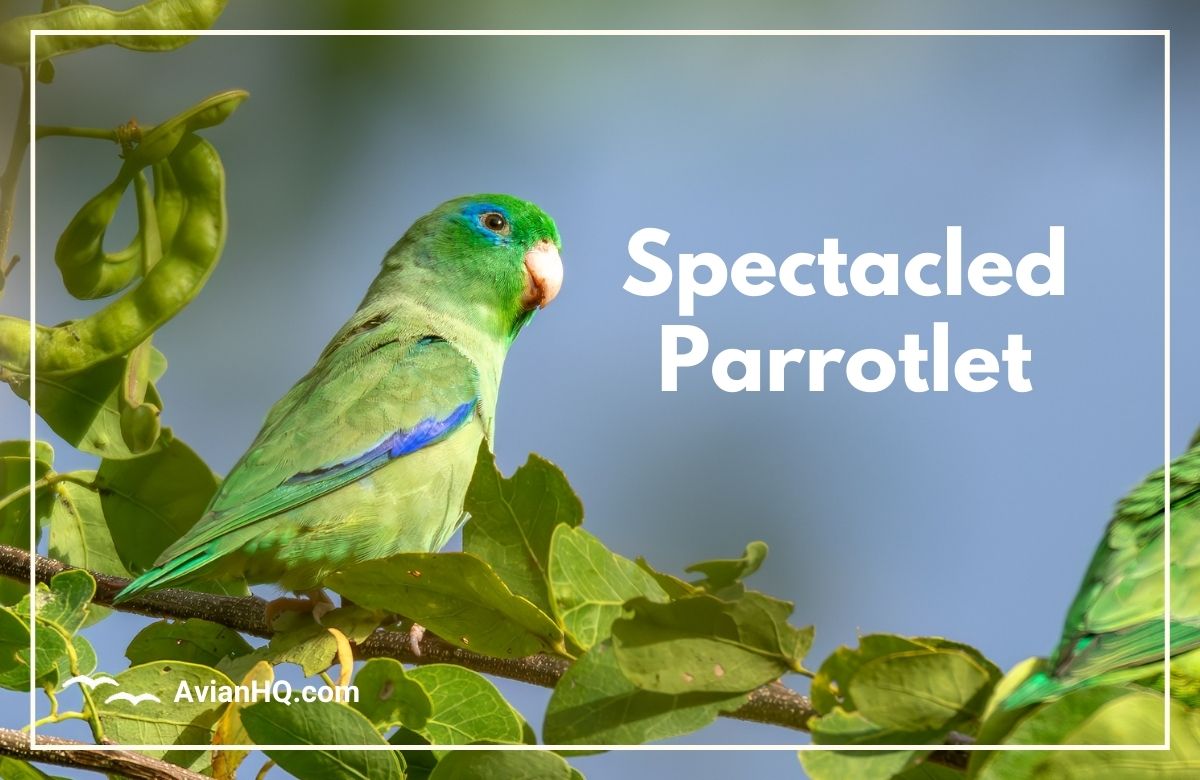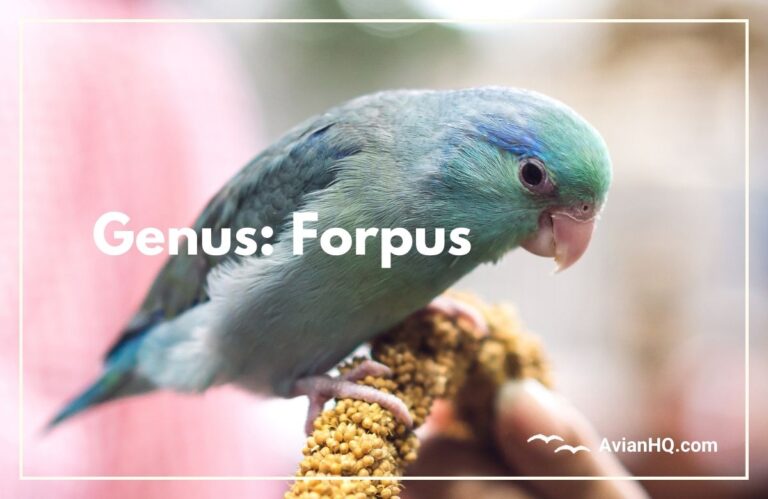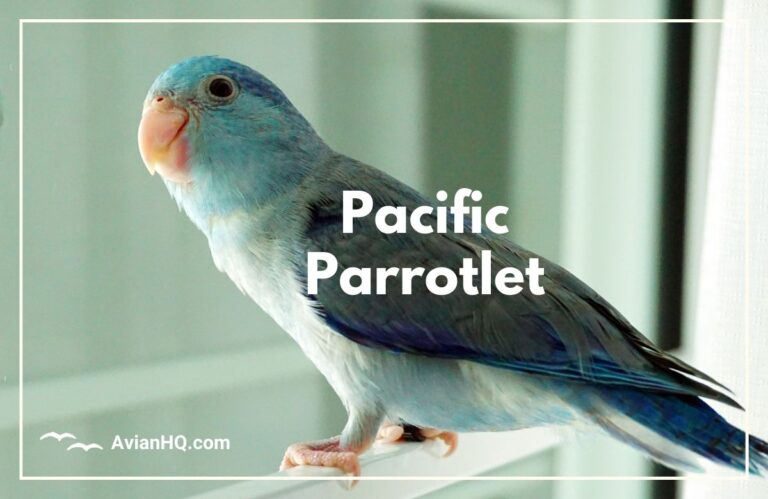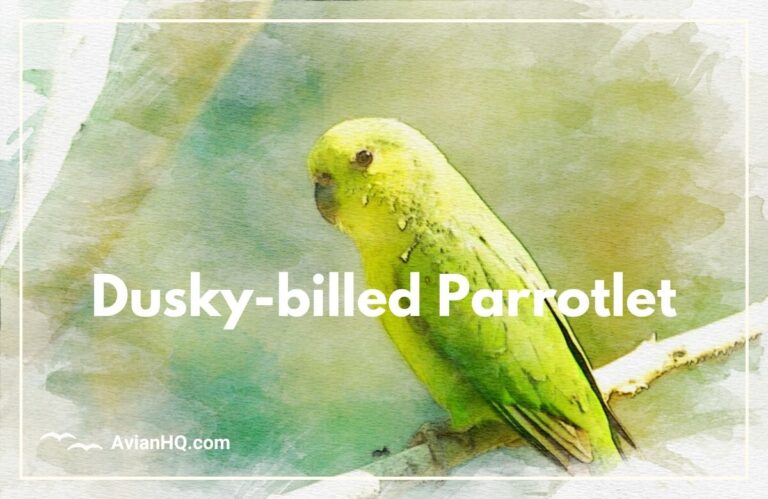Spectacled Parrotlet (Forpus conspicillatus)
You may have seen videos online of tiny, colorful parrots with big personalities. These pint-sized parrots are called parrotlets, and they make popular pets. Parrotlets are the smallest parrot species in the world, but they pack a lot of spirit into their tiny frames!
Of all the parrotlet varieties, one species always stands out for its distinctive facial markings. The Spectacled Parrotlet (Forpus conspicillatus) earns its name from the bright yellow rings around its eyes that resemble a pair of spectacles. This vibrant framing around its eyes gives it added personality.
Some quick facts about this eye-catching little parrotlet:
- Grows to about 4 to 41⁄2 inches (11 to 13 cm) and weighs .6 to .9 ounces (15 to 26 grams).
- Native range spreads across parts of Peru, Brazil, and Bolivia.
- Feeds on seeds, fruits, berries, and insects in the wild.
- Lays 3-5 tiny white eggs in tree cavities.
- Has an average lifespan of 8+ years.
- Has a green back, blue wings and tail, yellow underparts, and of course, distinct “spectacles.”
In this article, you’ll learn all about the history, physical appearance, habitat, diet, breeding habits, behavior, conservation status, and cultural significance of the Spectacled Parrotlet. This comprehensive guide will give you an appreciation for this adorable little bird.
“Though the Spectacled Parrotlet may be tiny in stature, it has a gigantic personality!”
Let’s start with the history and discovery of this small parrot with the big charm.
History and Taxonomy
The Spectacled Parrotlet was first identified and described in scientific literature in 1818 by French ornithologist Louis Jean Pierre Vieillot. Vieillot named the species Psittacus conspicillatus, grouping it within the larger parrot genus of Psittacus.
Over the next two centuries, the Spectacled Parrotlet was reclassified under various names as its taxonomy shifted:
- 1832 – Moved to the genus Sittace by German naturalist Johann Georg Wagler
- 1854 – Placement in the new genus Touit by British ornithologist Philip Lutley Sclater
- 1906 – French ornithologist Émile Oustalet assigned it to the Forpus genus
Today, the Spectacled Parrotlet is known by its current scientific name of Forpus conspicillatus. This name signifies its classification within the Forpus genus of small Neotropical parrotlets.
Forpus parrotlets are part of the wider Psittacidae family of parrots, which includes about 372 species. The Spectacled Parrotlet belongs to the subfamily of Arinae, or the typical small parrots comprising about 187 species.
So while originally lumped in with larger parrot species, adjustments to the Spectacled Parrotlet’s taxonomy over the past two centuries have honed in on its relationships with other tiny parrotlet peers. Its distinctive looks with vibrant plumage and bold spectacles keep it standing out, even among its diminutive relatives.
Physical Appearance
The Spectacled Parrotlet is one of the smaller parrot species, measuring just 4 to 41⁄2 inches (11 to 13 cm) in length. It is a stocky little bird, weighing approximately .6 to .9 ounces (15 to 26 grams).
The plumage of the Spectacled Parrotlet is vibrantly colored. Its back and rump feathers are primarily green. The wings and tail have hues of rich cobalt blue, while the breast and belly feathers are a bright golden yellow. As the name suggests, this parrotlet has distinct ivory white rings around its eyes that resemble spectacles. The beak shape is short and stubby, and is a gray-black color.
Males and females look very similar, with no significant differences in their coloration or size. Juveniles just out of the nest have a duller version of the adult plumage. Their initial feathers lack the intensity of color, especially in the spectacles around the eyes. The juvenile’s beak is more pinkish in color. After the first molt generally between 3-4 months old, the juveniles start to resemble the vibrant colors of mature Spectacled Parrotlets.
This parrotlet only goes through one molt per year. Their molt period lasts 4-5 weeks generally in the spring season. During the molt, they shed their head feathers first, followed by the body and wing feathers. Their bright coloration starts to grow back quickly after molting the old feathers. Proper nutrition is important during the molting period to enable new feather regrowth.
The defining feature of this little parrot remains its unique spectacled facial markings. It wears these distinctive “glasses” like a mask around its eyes as it flits through treetops.
Habitat and Distribution
The Spectacled Parrotlet resides in an environment of tropical and subtropical forests across parts of South America. Its native range covers southeastern Peru, northern Bolivia, and the western Brazilian states of Acre and Amazonas.
This species prefers lower mountain forests and woodlands up to elevations of 3,300 feet (1,000 meters). It lives along forest edges bordering clearings and areas of secondary growth. The Spectacled Parrotlet also adapts well to wooded habitats modified for agriculture and human settlements.
Several key aspects of its favored habitats include:
- Canopy Height: Prefers the middle strata level of forest canopies. Nesting cavities are excavated in trees 33-66 feet (10–20 meters) high.
- Proximity: Typically not found deep within primary interior rainforests. Inhabits transitional zones along edges.
- Vegetation Density: Requires at least pockets of dense wooded vegetation for nesting and cover.
- Food Availability: Needs ongoing sources of seeds, fruits, berries, buds, and edible flowers to forage on.
Though adaptable to some habitat disturbance, preserving areas of healthy woodlands is important for the continuity of Spectacled Parrotlets within their native environments across Peru, Bolivia and Brazil. Supporting the conservation of their remaining old growth forests helps create a safety net for their future.
Diet and Feeding
The Spectacled Parrotlet is an opportunistic generalist when it comes to its dietary needs. It forages on a flexible combination of different seeds, fruits, berries, buds, edible flowers, and the occasional insect snack.
This species uses its cliff-shaped beak like a can-opener to crack into seeds and fruits to reach the fleshy interior contents. Favored feed includes:
- Seeds of grasses, herbaceous plants, and the seed pods of woody shrubs
- Berries and fruits including figs, papaya, and cecropia
- Edible blossoms and nectar from flowers
- Larvae, ants, termites, and other small insects
Spectacled Parrotlets need to eat approximately 10-20% of their body weight each day. A parrotlet weighing .9 ounces (26 grams) would need to eat up to .18-.36 ounces (5–10 grams) of food per day.
They use their strong tongue muscle to maneuver and swallow larger bites of food. In the wild, Spectacled Parrotlets spend 60-80% of daylight hours continuously foraging and feeding on their various food sources.
Captive Spectacled Parrotlets should be fed a nutritionally balanced diet. A good quality small hookbill pellet provides a base. This can be supplemented with a rotating assortment of seeds, veggies, fruits, greens, sprouts, and healthy people foods. Continually introducing new flavors and textures also helps stimulate their active minds.
Breeding and Reproduction
Spectacled Parrotlets reach sexual maturity for breeding between 18 months to 2 years old. The breeding season aligns with the start of the rainy season between November and March each year.
When ready to breed, Spectacled Parrotlets use their short chisel-shaped beaks to excavate nesting cavities in the soft dead wood of trees. Favorite nest trees include species like Cecropia and Coussapoa. The nesting cavity is excavated to a depth of 4-8 inches (10-20 cm) wide enough for the pair.
Once bonded with a mate, the pair works closely together to create the nest. The female then lays a small clutch of 3-5 eggs within the cavity. The oval shaped eggs are a creamy white coloration and measure approximately .6 x .4 inches (15 x 11 mm).
Only the female Spectacled Parrotlet incubates the eggs. She alternates sitting periods of 45-60 minutes on the nest. The full incubation period lasts 23-24 days until the altricial chicks hatch.
Both parents share duties caring for and feeding the young nestlings. For the first week, the female only leaves the nest for quick stretches to eat. The male faithfully brings food back to feed both the female and the babies. As the chicks grow and require more nutrition over the 5-6 week nestling phase, both parents gather food to feed the clutch.
Fledging occurs around 42 days when the juveniles emerge from the nest cavity on their maiden voyage. The parents continue supplementing the fledglings with additional feedings as they teach them to forage on their own. With attentive parental care, most chicks successfully leave the nest to continue the Spectacled Parrotlet lifecycle.
Behavior and Ecology
The Spectacled Parrotlet is a highly social and active little bird. They live in large communal flocks that can number into the hundreds. Each morning, these big flocks break off into smaller cohorts of 10-30 birds to better forage across their territory for food. By evening, they return to reconvene with the larger flock at shared roosting cavities.
Spectacled Parrotlets are constantly zipping from perch to perch within trees and interacting with their flock mates. Favorite activities include preening each other, passing tidbits of food, squabbling over prime perching spots, and playing together. They enjoy manipulating twigs, leaves, seeds and other items with their nimble beaks and feet. This intelligence also serves them well for excavating their nesting cavities.
Vocalizations are an important element of their social structure. Spectacled Parrotlets utilize a diversity of chirping, whistling and chatter sounds to communicate different messages with their flocks. Distinct alarm calls alert others to danger, while separate chirps signify contentment or discoveries of abundant food sources to share.
Roosting cavities are highly valuable resources that Spectacled Parrotlets diligently guard access to within their home ranges. However, conflicts between Spectacled Parrotlets and other cavity nesters can arise around suitable nesting sites. Competitors like woodpeckers may try to annex prime real estate. Larger parrots may also bully Spectacled Parrotlets away from roosts. But despite their small size, Spectacled Parrotlets fiercely defend their territories.
With tight social bonds and communally shared resources, Spectacled Parrotlets continue exhibiting complex behaviors and interactions within their native habitats in Peru, Bolivia and Brazil. Protecting sufficient mature woodland areas for their needs remains an ongoing conservation priority.
Conservation Status
The Spectacled Parrotlet has a wide range across the Amazon basin region of South America. However, habitat loss threatens localized populations, especially in southeastern Peru where agricultural conversion has intensified.
Across its range, current population estimates number:
- Peru: Fewer than 1,000 birds
- Bolivia: 5,000 – 10,000 birds
- Brazil: Unknown, likely several thousand
The Spectacled Parrotlet is classified as Least Concern on the IUCN Red List of Threatened Species. But in Peru, it is designated as Vulnerable under Supreme Decree No. 004-2014-MINAGRI, providing the species federal protections.
Major threats include:
- Deforestation destroying nesting and feeding habitat
- Capture for illegal pet trade
- Competition for nesting cavities
Conservation actions needed to protect Spectacled Parrotlets include:
- Preserving old growth and secondary forest habitats
- Enforcing legal protections for the species
- Continued population monitoring
- Community education on sustainable practices
Raising local awareness and empowering communities to steward their forests and wildlife provides the best chance for Spectacled Parrotlets to continue brightening the skies over the Amazon. Their uniqueness and charm merits increased conservation effort.
Cultural Significance
The vibrant beauty of the Spectacled Parrotlet has made it an increasingly popular species in the international pet trade. As agriculture and land development in southeastern Peru encroaches on their habitat, many Spectacled Parrotlets get captured and sold illegally as pets.
While this generates money for impoverished local communities struggling with few resources, it greatly threatens already declining wild Spectacled Parrotlet numbers. Captive breeding programs in Europe and the United States work to produce pet Spectacled Parrotlets ethically without further endangering wild populations.
The Spectacled Parrotlet’s bright plumage and comical spectacles have also made it a favorite among aviculturalists. In captivity, Spectacled Parrotlets are quite hardy provided their special needs for nutrition, social interaction and mental enrichment are adequately met. Their mischievous and affectionate personalities continue charming more fans.
For the indigenous Asháninka people of the Peruvian rainforest, the Spectacled Parrotlet carries cultural symbolism for enabling clearer visions to guide the future. Just as its “spectacles” frame its sight and perception of the world, indigenous elders known as Shatéri wore traditional glasses to showcase expanded wisdom and connection with all living beings guiding collective understanding.
From illegal pet trade trafficking to positive captive breeding efforts and moving spiritual significance, the tiny Spectacled Parrotlet has gained increased cultural attention, especially as its specialized wild habitat grows ever scarcer in our rapidly developing world.
Conclusion
For a tiny parrot weighing less than an ounce, the Spectacled Parrotlet has made a huge impression across the Americas. From its small stature but oversized personality to its threatened status in the wild to its growing popularity in captivity, this visually striking bird captures attention.
The Spectacled Parrotlet’s vibrant green, blue and yellow plumage accented by its distinct “spectacled” eye rings makes it one of the most adorable parrot species on Earth. But beyond its cute appearance, it exhibits fascinating behaviors woven into the social fabric of fast-moving flocks numbering in the hundreds. It cooperates to build nests, forage far and wide for food, and guard precious roosting sites within its territories.
While still considered a species of Least Concern globally, the rapid destruction of forests in pockets of its range, especially in Peru, dangerously constricts available habitat and risks localized extinction. Raising awareness, empowering local communities, and preserving critical old growth forest ecosystems remain key to ensuring viable Spectacled Parrotlet populations for future generations.
From the treetop canopies of the Amazon to the homes of parrot enthusiasts across the world, the Spectacled Parrotlet has won many fans. Ensuring the conservation of this special small parrot in the wild enables its spirited legacy to persist.






